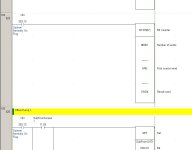dajody
Member
Hi. I'm relatively new to PLC programming so this may be a simple question and I'm just overlooking the easy way to do things.
The machine I'm dealing with uses an OMRON CJ1M CPU12 plc (using CX-Programmer 4.0 software).
I'm trying to figure out a way to monitor 8 separate proximity sensor inputs and set an output work bit high when ANY 5 of these inputs is on. Based on mathematical combination there are a total of 56 possible combinations. I could use 56 lines and write out all 56 possible combinations, but it seems like there must be an easier way. As I mentioned I'm fairly new to PLC programming (I've read a few books and basically learned on the fly with some new equipment we purchased at work), so there may be some functions I just haven't been exposed to yet.
Anyway, I'd appreciate any help. Let me know if more information is required. Thanks.
Dave
The machine I'm dealing with uses an OMRON CJ1M CPU12 plc (using CX-Programmer 4.0 software).
I'm trying to figure out a way to monitor 8 separate proximity sensor inputs and set an output work bit high when ANY 5 of these inputs is on. Based on mathematical combination there are a total of 56 possible combinations. I could use 56 lines and write out all 56 possible combinations, but it seems like there must be an easier way. As I mentioned I'm fairly new to PLC programming (I've read a few books and basically learned on the fly with some new equipment we purchased at work), so there may be some functions I just haven't been exposed to yet.
Anyway, I'd appreciate any help. Let me know if more information is required. Thanks.
Dave





